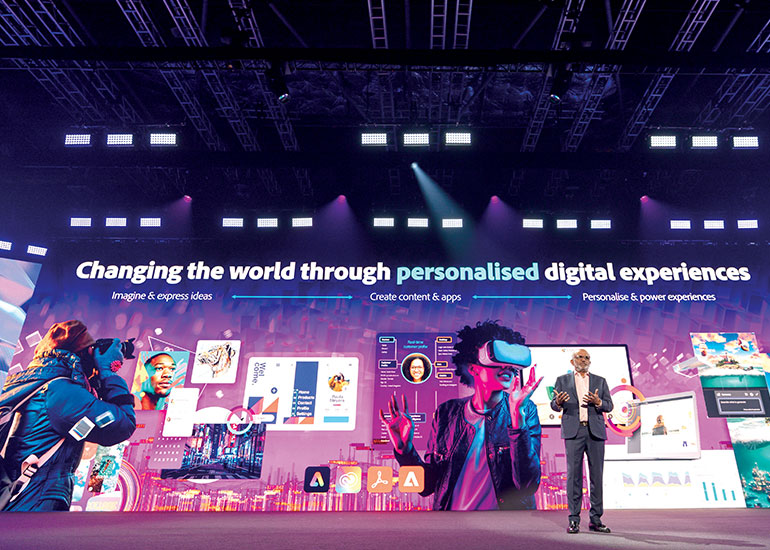Just like the takeover of white sneakers at corporate events, Generative AI seems to have become the holy bible of all tech companies. A platform such as ChatGPT hit 100 million users in just two months since its launch, a number which popular apps like Tiktok and Instagram took 9 and 30 months, respectively to reach, as per data shared by the World of Statistics and Unsplash. There is no mistaking the popularity of Generative AI, and it thus came as no surprise when it clearly dictated the agenda at the recently concluded Adobe Summit EMEA, 2023 in London, too. At the summit, Shantanu Narayen, Chairman and CEO of Adobe highlighted how Creativity is the new productivity, and that there is an insatiable demand for dynamic content from across sectors like digital healthcare, financial services and retail, with consumers expecting that the brands they connect with in turn know them well. That is where AI comes in. Narayen said, “We are infusing artificial intelligence in all our products, driven by the mission of changing the world through personalised experiences.”
At the summit, Shantanu Narayen, Chairman and CEO of Adobe highlighted how Creativity is the new productivity, and that there is an insatiable demand for dynamic content from across sectors like digital healthcare, financial services and retail, with consumers expecting that the brands they connect with in turn know them well. That is where AI comes in. Narayen said, “We are infusing artificial intelligence in all our products, driven by the mission of changing the world through personalised experiences.”
Adobe has extensively invested in Adobe Sensei, an artificial intelligence (AI), and machine learning technology in the past year, and subsequently gone on to launch features like new AI neural filters in Photoshop, and Liquid Mode in acrobat, which is a revolutionary mobile reading experience powered by Adobe Sensei that enhances your PDF layout. It has also added features on the fly for easy reading. Adobe introduced Customer AI as part of Intelligent Services, and provided marketers with the power to generate customer predictions at the individual level with explanations.
As per Adobe, Content demand has grown 2X in the past two years, and is expected to grow 5X in the coming two years. Calling Adobe a facilitator in creation of this content, Narayen said, “AI is our co-pilot in our everyday life, while for all businesses it represents a greater opportunity for automation in creativity. We started with products that aided in content creation, and then expanded our focus on data to have insights on how content is performing, further going on to customer segmentation and acquisition.”
The conference kicked off with a powerful new generative AI offering that brings Adobe Firefly and Adobe Express to enterprises around the world. Firefly for Enterprise is designed to address the surging demand of digital content at scale and help enterprises streamline and accelerate content creation while optimizing costs. The new company-wide offering enables every employee across an organization, at any creative skill level to use Firefly to generate beautiful, on-brand, ready-to-share content that can be seamlessly edited in Express or Creative Cloud. Interestingly, since its launch in March, Firefly beta users have generated over 200 million images. Photoshop users have generated over 150 million images in just two weeks using the new Generative Fill feature powered by Firefly. David Wadhwani, President, Digital Media Business, Adobe says, “Adobe Firefly was built ground up to make it fit for commercial use, and we can say that confidently because we track all the data that went into training the model, right from the start to the output. It has also been integrated in the existing workflow in photoshop. For e.g., a narrow image can be expanded and elements like boats, humans and even reflections can be added to it, all with the help of a simple text prompt. It will greatly empower the marketing team, while supercharging creative teams.”
David Wadhwani, President, Digital Media Business, Adobe says, “Adobe Firefly was built ground up to make it fit for commercial use, and we can say that confidently because we track all the data that went into training the model, right from the start to the output. It has also been integrated in the existing workflow in photoshop. For e.g., a narrow image can be expanded and elements like boats, humans and even reflections can be added to it, all with the help of a simple text prompt. It will greatly empower the marketing team, while supercharging creative teams.”
Adobe has a host of products, from Creative Cloud including Photoshop, Illustrator, Premiere Pro, InDesign etc. to Adobe Experience Cloud, with a set of analytics, social, advertising, media optimization, targeting, web experience management, journey orchestration, and content management products that are needed to deliver personal and relevant experiences across channels.
 While delivering a keynote address at the summit, Anil Chakravarthy, President, Digital Experience Business, Adobe said that of late consumers expect every company to be digital first, and as far as companies are concerned, a good customer experience is imperative for profitable growth. “Brands that compete on the basis of experience don’t have to compete on price. They must have the ability to personalise at scale in this era of experience-led growth, which is about connecting customer experience across acquisition, retention, etc. Adobe is the only partner that can aid brands in all stages of their content journey, namely –planning, production, delivery, and analysis,” adds Chakravarthy.
While delivering a keynote address at the summit, Anil Chakravarthy, President, Digital Experience Business, Adobe said that of late consumers expect every company to be digital first, and as far as companies are concerned, a good customer experience is imperative for profitable growth. “Brands that compete on the basis of experience don’t have to compete on price. They must have the ability to personalise at scale in this era of experience-led growth, which is about connecting customer experience across acquisition, retention, etc. Adobe is the only partner that can aid brands in all stages of their content journey, namely –planning, production, delivery, and analysis,” adds Chakravarthy. Luc Dammann, President of EMEA, Adobe says, “We are in an era where 2% of consumers are ready to move away from the brand they love if they have one bad experience, where recommendations are fast killing favourites. Data on past behaviours can’t be relied on anymore, and aspirations and tastes are changing every day, so brands need to know what is happening live. Customer experience provides the competitive advantage. Personalisation at scale in real time is the need of the hour and Adobe has the capability to do all of that.”
Luc Dammann, President of EMEA, Adobe says, “We are in an era where 2% of consumers are ready to move away from the brand they love if they have one bad experience, where recommendations are fast killing favourites. Data on past behaviours can’t be relied on anymore, and aspirations and tastes are changing every day, so brands need to know what is happening live. Customer experience provides the competitive advantage. Personalisation at scale in real time is the need of the hour and Adobe has the capability to do all of that.”
Three months ago, the Godfather of AI, Geoffrey Hinton, quit his job to warn the world about the dangers of AI after calling humans no match for it. Humanity is torn between two opposite schools of thought, where on one hand AI is believed to enhance productivity, and on the other, people think it will take us closer to doomsday.

As per Scott Belsky, Chief Strategy Officer and EVP, Design & Emerging Products, Adobe, it can’t be clearer that AI is a boon, he explains, “Wildly human-intensive and non-scalable experiences will become economically viable in the age of AI. In companies, humans will be redeployed towards higher order tasks and non-scalable activities that make all the difference.”
But the lingering question is – are we unlocking unique human potential or replacing humans? Only time will tell. At a time when NASA is designing new spaceship parts with Generative AI, one can’t discount the kind of impact technology can have on speeding up our progress in multiple spheres. We also can’t help but wonder if real life business utility truly supersedes the possible hypothetical threats like ‘Robots are coming’. As far as the business of creativity is concerned, Adobe’s AI stack certainly looks like it can add a lot of value to the lives of marketers and creative professionals.























